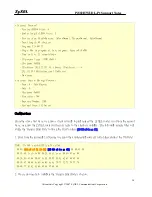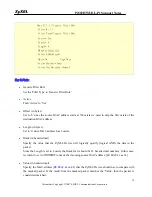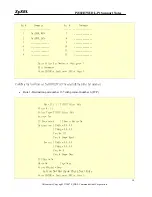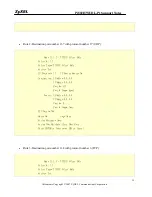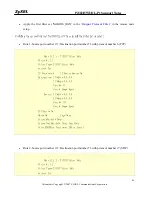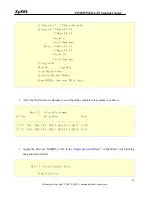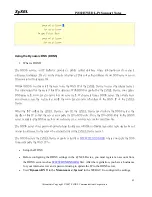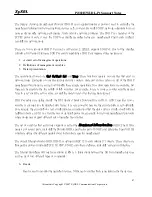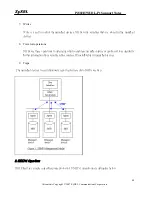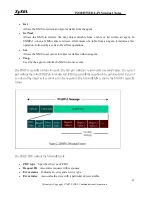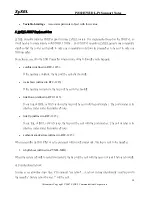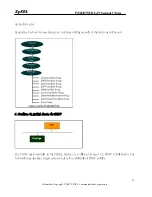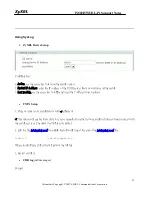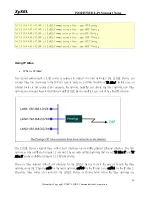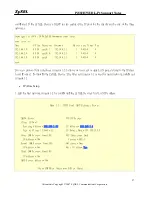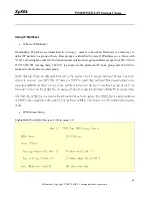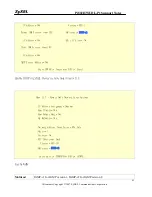
P2302HWUDL-P1 Support Notes
All contents Copyright
2007 ZyXEL Communications Corporation.
47
The
Simple Network Management Protocol
(SNMP) is an applications-layer protocol used to exchange the
management information between network devices (e.g., routers). By using SNMP, network administrators can
more easily manage network performance, find and solve network problems. The SNMP is a member of the
TCP/IP protocol suite, it uses the UDP to exchange messages between a management Client and an Agent,
residing in a network node.
There are two versions of SNMP: Version 1 and Version 2. ZyXEL supports SNMPv1. Most of the changes
introduced in Version 2 increase SNMP's security capabilities. SNMP encompasses three main areas:
1.
A small set of management operations.
2.
Definitions of management variables.
3.
Data representation.
The operations allowed are: Get, GetNext, Set, and Trap. These functions operate on variables that exist in
network nodes. Examples of variables include statistic counters, node port status, and so on. All of the SNMP
management functions are carried out through these simple operations. No action operations are available, but
these can be simulated by the setting of flag variables. For example, to reset a node, a counter variable named
'time to reset' could be set to a value, causing the node to reset after the time had elapsed.
SNMP variables are defined using the OSI Abstract Syntax Notation One (ASN.1). ASN.1 specifies how a
variable is encoded in a transmitted data frame; it is very powerful because the encoded data is self-defining.
For example, the encoding of a text string includes an indication that the data unit is a string, along with its
length and value. ASN.1 is a flexible way of defining protocols, especially for network management protocols
where nodes may support different sets of manageable variables.
The net of variables that each node supports is called the
Management Information Base
(MIB). The MIB is
made up of several parts, including the Standard MIB, specified as part of SNMP, and Enterprise Specific MIB,
which are defined by different manufacturer for hardware specific management.
The current Internet-standard MIB, MIB-II, is defined in RFC 1213 and contains 171 objects. These objects are
grouped by protocol (including TCP, IP, UDP, SNMP, and other categories, including 'system' and 'interface.'
The Internet Management Model is as shown in figure 1. Interactions between the NMS and managed devices
can be any of four different types of commands:
6.
Reads
Read is used to monitor the managed devices, NMSs read variables that are maintained by the devices.
Summary of Contents for P-2302HWUDL-P1 Series
Page 11: ...P2302HWUDL P1 Support Notes All contents Copyright 2007 ZyXEL Communications Corporation 11...
Page 14: ...P2302HWUDL P1 Support Notes All contents Copyright 2007 ZyXEL Communications Corporation 14...
Page 109: ...P2302HWUDL P1 Support Notes All contents Copyright 2007 ZyXEL Communications Corporation 109...
Page 112: ...P2302HWUDL P1 Support Notes All contents Copyright 2007 ZyXEL Communications Corporation 112...
Page 116: ...P2302HWUDL P1 Support Notes All contents Copyright 2007 ZyXEL Communications Corporation 116...
Page 118: ...P2302HWUDL P1 Support Notes All contents Copyright 2007 ZyXEL Communications Corporation 118...
Page 122: ...P2302HWUDL P1 Support Notes All contents Copyright 2007 ZyXEL Communications Corporation 122...
Page 134: ...P2302HWUDL P1 Support Notes All contents Copyright 2007 ZyXEL Communications Corporation 134...
Page 138: ...P2302HWUDL P1 Support Notes All contents Copyright 2007 ZyXEL Communications Corporation 138...


